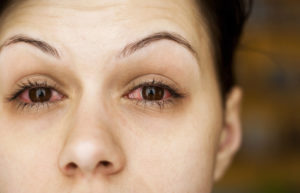March 19, 2018 | Black & Kletz Allergy

Most individuals with allergic conjunctivitis have associated allergic rhinitis (i.e., hay fever)where they have other symptoms which may include sneezing, runny nose, nasal congestion, post-nasal drip, itchy nose, itchy throat, sinus headaches, sinus pressure, and/or snoring. Asthmatic individuals may experience increased asthma symptoms in the Spring if they are sensitive to outdoor allergens such as tree pollen, grass pollen, and/or molds. It is not unusual for some individuals to experience increased asthma, allergic rhinitis, and allergic conjunctivitis symptoms together.
The diagnosis of allergic conjunctivitis begins with a comprehensive history and physical examination by a board certified allergist. Allergy skin testing or blood testing is usually performed in order to identify if and what the offending allergens are that are causing the allergic eye symptoms.
When evaluating an individual with the symptoms of eye allergies, it is important for the physician to rule out other causes of red eyes or “pink eye.” Viral, bacterial, and/or parasitic infections of the eye(s) can cause similar symptoms but are treated differently. Chemical irritation or a foreign body can also cause the eyes to become red. Anterior uveitis, which can be associated with an autoimmune disorder or a sexually transmitted disease, may also cause redness of the eyes. In addition, there is usually “photophobia” which is the pain in the eyes when in a bright environment. A subconjunctival hemorrhage or bleed may also occur when the capillaries break near the “whites” of the eyes. Some causes of subconjunctival hemorrhages may include trauma, coughing, straining, sneezing elevated blood pressure, diabetes, and/or certain blood thinning medications [e.g.., aspirin, Coumadin (warfarin), Plavix (clopidogrel), Eliquis (apixaban), Pradaxa (dabigatran), Xarelto (rivaroxaban), Brilinta (ticagrelor), Effient (prasugrel), Aggrenox (aspirin plus dipyridamole)]. They can also just occur spontaneously without an apparent cause.
The treatment of allergic conjunctivitis may include the use of various eye drops, oral antihistamines, nasal corticosteroids, leukotriene antagonists, and/or allergy shots (i.e., allergy injections, allergy immunotherapy, allergy desensitization, allergy hyposensitization). Of course, avoiding the offending allergen is the first and primary focus with any allergy, but in most cases, especially if allergic to the pollen in the Spring, it is almost impossible to avoid. That being said, there are still some avoidance measures that can be practiced in order to limit one’s exposure to pollen. Some of them are as follows:
- Close the windows of your home and automobiles.
- Change your clothes and shower after spending a long time outdoors or after yard work.
- Follow the local pollen count on our website by clicking Today’s Pollen Count.
- Go outdoors after it rains as the pollen count is “washed away” temporarily after the rain.
- Wash the fur of your pet after it comes indoors from the outside.
- Leave your shoes outdoors after being outdoors.
- Begin using nasal sprays and/or antihistamines early in the pollen season.
- Consider allergy shots, as mentioned above, if more severe or persistent symptoms to pollens and/or molds, as they generally are effective in 80-85% of individuals with allergic conjunctivitis and/or allergic rhinitis.
The board-certified allergy doctors at Black & Kletz Allergy are specialists in diagnosing and treating both adults and children with allergic conjunctivitis as well as many other allergic disorders. Some of these include allergic rhinitis, asthma, sinus disease, eczema (i.e., atopic dermatitis), hives (i.e. urticaria), generalized itching (i.e., pruritus), contact dermatitis (e.g., poison ivy, poison oak, poison sumac), swelling episodes (i.e., angioedema), anaphylaxis, insect sting allergies, food allergies, medication allergies, eosinophilic disorders (e.g., eosinophilic esophagitis), and immunological disorders. Black & Kletz Allergy has 3 convenient locations in the Washington, DC, Northern Virginia, and Maryland metropolitan area. We have offices in Washington, DC, McLean, VA (Tysons Corner), and Manassas, VA. All of our locations offer on-site parking and our Washington, DC and McLean, VA offices are Metro accessible. There is a free shuttle that runs between our McLean, VA office and the Spring Hill metro station on the silver line.
If you suffer from allergies or any of the conditions listed in the above paragraph, please call us in order to schedule an appointment with one of our board-certified allergists. You may also click Request an Appointment and we will respond within 24 hours by the next business day. The allergists at Black & Kletz have been helping the residents and visitors of the Washington, DC metropolitan area for more than 50 years and are pleased to help you improve the quality of your life by alleviating those unwanted and annoying allergies and asthma symptoms.












